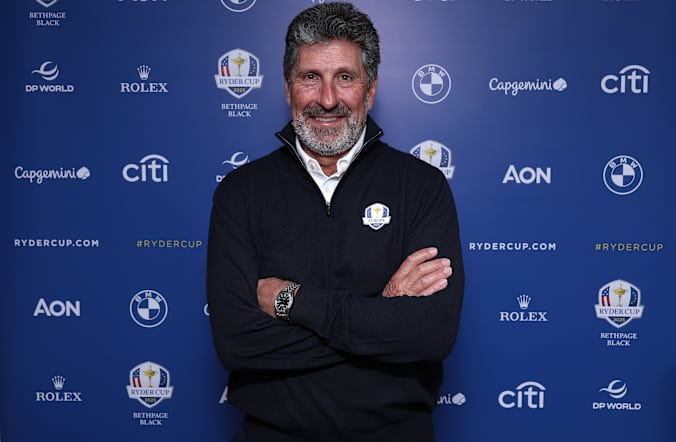

USA
U.S. Captain Steve Stricker sets out to solve Foursomes
By Jeff Babineau On September 21, 2021 18:49 UTC
KOHLER, WIS. – There are a lot of ways that identify the Ryder Cup as an event like few others. For instance, four players will stand on the first tee at Whistling Straits early Friday morning to begin the 43rd Ryder Cup, and only two golf balls will be struck.
U.S. Captain Steve Stricker has chosen to open his home-state Ryder Cup with Foursomes, a format that has not been very kind to the U.S. side for the last three decades. In 13 Ryder Cups contested since 1993, Europe has held the edge in Foursomes (alternate-shot) play nine of 13 times.
Three years ago in Paris, Europe finished 6-2-0 over two Foursomes sessions, helping to fuel a 17.5-10.5 victory at Le Golf National. Seven years ago in Scotland, at Gleneagles, the Foursome sessions were even more lopsided in Europe’s favor. Europe went unbeaten in eight matches, winning six and tying two others.
Though opening up with what would be considered the weaker of its two team formats, the U.S. will hope to do what it did the last time it prevailed in the Ryder Cup. At Hazeltine in 2016, with Arnold Palmer’s Ryder Cup bag positioned on the first tee just days after Palmer’s passing, an inspired U.S. side went out and whitewashed the Europeans in an opening Foursomes session, 4-0.

Foursomes has long been a staple at many clubs across the United Kingdom and Europe – many of which host days where golfers play nothing but alternate-shot – but the format remains rather foreign to American players. Maybe they played it in a Walker Cup years ago, or a Presidents Cup, or an occasional World Cup. The PGA Tour’s Zurich Classic in New Orleans features two days of Foursomes. But it’s a different game, taking a player out of his normal cadence and rhythm. Foursomes is about getting two golfers together who are comfortable enough to not apologize to each other after an errant shot.
American Rickie Fowler joked a few years ago that when he gets to a great golf course, he wants to hit all the shots – not every other one.
“I was brought up playing Foursomes,” said European Ryder Cup Team Captain Padraig Harrington, who learned the game in Ireland. “Played it a lot in amateur golf, many in my team have. It's not really alien to us... we don't read that much into it. I think sometimes when people haven't played, it they can over-complicate it.
“It's played at our golf clubs at home, not just in championships. It's a very common game, and really don't read into it any more than there should be... It's just two guys playing a golf ball around the place. It's not that difficult.”
The U.S. has had difficulty identifying reliable pairings in the format, and thus ends up tinkering with different combinations. There was a time years ago when captains might pair players who played the same model golf ball, regardless of how their personalities really meshed.
In 2006, before the Ryder Cup visited the K Club in Ireland, the one-ball rule was relaxed in Ryder Cup Foursomes. Instead of a two-man team being required to use the same make and model of golf ball for the entire match, at the home captain's discretion, teams have been allowed to switch balls on every tee. Strategy-wise, if the individuals use different model balls, a decision usually is made to match up the player who will be hitting the team's iron shot into the green with the ball he regularly plays. The priority is distance control.
This time around, U.S. Captain Steve Stricker would seem to have no fewer than two proven tandems to send out on Friday to start these matches: Justin Thomas and Jordan Spieth were able to win a Foursomes match in Paris, thumping Rory McIlroy and Ian Poulter, 4 and 3. And Ryder Cup rookies Patrick Cantlay and Xander Schauffele had instant success as a Foursomes team at the 2019 Presidents Cup in Australia, winning both of their matches.

“I think we always tend to try to look for guys with similar game styles or game styles that would complement the other player,” Stricker said. “Good putting always is a big key I think in alternate-shot, or in Foursomes.
“You look for the guys who embrace that. That's the important part. Some guys, they don't care for that style of play. Other guys want to play it. It depends on the player and it's up to us or our job to try to figure out those guys and try to pair the games together that make the most sense.”
Foursomes aren’t for everyone, and many times those who have success are the same style players who have a penchant to grind out a score on those tough championship days they don’t have everything going their way.
“In Foursomes, it's more the grinders,” said Thomas Bjorn, who captained Europe to victory in 2018 in Paris. “It's more the people that work hard on the golf course, and don't give too many things away, and grind it out. Those are the guys that make great Foursomes players.”



